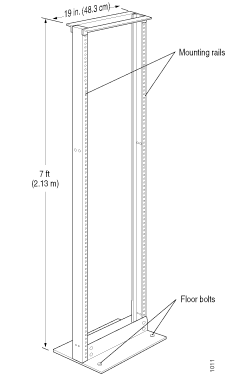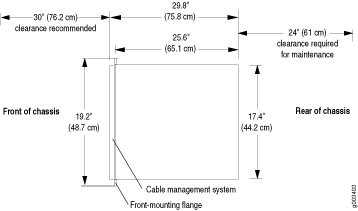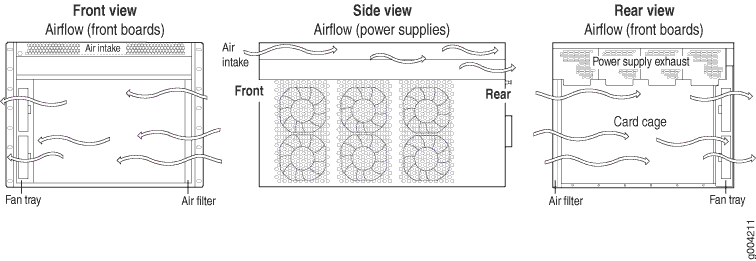MX240 Site Guidelines and Requirements
MX240 Router Physical Specifications
Table 1 summarizes the physical specifications for the router chassis.
Description |
Weight |
Width |
Depth |
Height |
|---|---|---|---|---|
Chassis dimensions |
Chassis with midplane, fan tray, air filter: 52 lb (23.6 kg) Maximum configuration: 128 lb (58.1 kg) |
17.45 in. (44.3 cm) |
24.5 in. (62.2 cm) (from front-mounting bracket to chassis rear) Total depth: 27.75 in. (70.5 cm) |
8.71 in. (22.1 cm) |
Routing Engine (RE-S-1800) |
2.4 lb (1.1 kg) |
11 in. (27.9 cm) |
7.75 in. (19.7 cm) |
1.25 in. (3.2 cm) |
Routing Engine (RE-S-X6-64G) |
2.69 lb (1.18 kg) |
10.7 in. (27.18 cm) |
7.47 in. (18.97 cm) |
1.19 in. (3.02 cm) |
SCB |
9.6 lb (4.4 kg) |
17 in. (43.2 cm) |
22 in. (55.9 cm) |
1.25 in. (3.2 cm) |
SCBE |
9.6 lb (4.4 kg) |
17 in. (43.2 cm) |
22 in. (55.9 cm) |
1.25 in. (3.2 cm) |
SCBE2 |
9.6 lb (4.4 kg) |
17 in. (43.2 cm) |
22 in. (55.9 cm) |
1.25 in. (3.2 cm) |
DPC |
Maximum up to 14.5 lb (6.6 kg) Blank panel in DPC slot: 9 lb (4.1 kg) |
17 in. (43.2 cm) |
22 in. (55.9 cm) |
1.25 in. (3.2 cm) |
FPC |
FPC2: 13 lb (5.9 kg) FPC3: 14 lb (6.5 kg) |
17 in. (43.2 cm) |
22 in. (55.9 cm) |
2.5 in. (6.4 cm) |
PIC |
2 lb (0.9 kg) |
7.75 in. (28.3 cm) |
11.125 in. (19.7 cm) |
4.125 in. (10.5 cm) |
MPC (fixed configuration) |
18.35 lb (8.3 kg) |
17 in. (43.2 cm) |
22 in. (55.9 cm) |
1.25 in. (3.2 cm) |
MPC (without MICs) |
14 lb (6.4 kg) |
17 in. (43.2 cm) |
22 in. (55.9 cm) |
1.25 in. (3.2 cm) |
MIC |
Maximum up to 1.2 lb (0.54 kg) |
6.25 in. (15.9 cm) |
6.8 in. (17.3 cm) |
1.25 in. (3.2 cm) |
Craft interface |
1.1 lb (0.5 kg) |
21.25 in. (54 cm) |
8.5 in. (21.6 cm) |
6.25 in. (15.9 cm) |
Fan tray |
4.2 lb (1.9 kg) |
17 in. (43.2 cm) |
22 in. (55.9 cm) |
1.5 in. (3.8 cm) |
Air filter |
1 lb (0.5 kg) |
0.31 in. (0.8 cm) |
22.23 in. (56.5 cm) |
5 in. (12.7 cm) |
DC power supply |
3.8 lb (1.7 kg) |
14.5 in. (36.8 cm) |
4 in. (10.2 cm) |
1.75 in. (4.4 cm) |
High-capacity DC power supply |
6.2 lb (2.81 kg) |
14.5 in. (36.8 cm) |
4 in. (10.2 cm) |
1.75 in. (4.4 cm) |
AC power supply |
5 lb (2.3 kg) |
14.5 in. (36.8 cm) |
4 in. (10.2 cm) |
1.75 in. (4.4 cm) |
High-capacity AC power supply |
6.6 lb (2.99 kg) |
14.5 in. (36.8 cm) |
4 in. (10.2 cm) |
1.75 in. (4.4 cm) |
See Also
MX240 Router Environmental Specifications
Table 2 specifies the environmental specifications required for normal router operation. In addition, the site should be as dust-free as possible.
Description |
Value |
|---|---|
Altitude |
No performance degradation to 10,000 ft (3048 m) |
Relative humidity |
Normal operation ensured in relative humidity range of 5% to 90%, noncondensing |
Temperature |
Normal operation ensured in temperature range of 32°F (0°C) to 104°F (40°C) Nonoperating storage temperature in shipping container: –40°F (–40°C) to 158°F (70°C) |
Seismic |
Designed to meet Telcordia Technologies Zone 4 earthquake requirements |
Maximum thermal output |
AC power: 7161 BTU/hour (2100 W) DC power: 5074 BTU/hour (1488 W) |
Install the router only in restricted areas, such as dedicated equipment rooms and equipment closets, in accordance with Articles 110-16, 110-17, and 110-18 of the National Electrical Code, ANSI/NFPA 70.
See Also
MX240 Router Rack Requirements
The router can be installed in many types of racks, including four-post (telco) racks and open-frame racks.
The router can be installed in many types of racks, including four-post (telco) racks and open-frame racks. An example of an open-frame rack appears in Figure 1. Table 3 summarizes rack requirements and specifications for an MX240 Router.
Rack Requirement |
Guidelines |
|---|---|
Rack type and mounting bracket hole spacing |
Use a four-post rack or a two-post rack. You can mount the router on any four-post or two-post rack that provides bracket holes or hole patterns spaced at 1 U (1.75-in./4.44-cm) increments and that meets the size and strength requirements specified in this table. A U is the standard rack unit defined Cabinets, Racks, Panels, and Associated Equipment (document number EIA-310-D) published by the Electronic Components Industry Association (ECIA). |
Rack size and strength |
|
Rack connection to the building structure |
|

See Also
MX240 Router Clearance Requirements for Airflow and Hardware Maintenance
When planning the installation site, allow sufficient clearance around the rack (see Figure 2):
For the cooling system to function properly, the airflow around the chassis must be unrestricted. Allow at least 8 in. (20.3 cm) of clearance between side-cooled routers. Allow 5.5 in. (14 cm) between the side of the chassis and any non-heat-producing surface such as a wall.
For service personnel to remove and install hardware components, there must be adequate space at the front and back of the router. At least 24 in. (61 cm) is required both in front of and behind the router. NEBS GR-63 recommends that you allow at least 30 in. (72.6 cm) in front of the rack and 24 in. (61.0 cm) behind the rack.
Airflow must always be from front to back with respect to the rack. If the device has side to rear airflow, then provisions must be made to ensure that fresh air from the front of the rack is supplied to the inlets, and exhaust exits the rear of the rack. The device must not interfere with the cooling of other systems in the rack. Fillers must be used as appropriate in the rack to ensure there is no recirculation of heated exhaust air back to the front of the rack. Care must also be taken around cables to ensure that no leakage of air in situations where recirculation may result.

MX240 Router Cabinet Size and Clearance Requirements
The minimum-sized cabinet that can accommodate the router is 482-mm wide and 800-mm deep. A cabinet larger than the minimum requirement provides better airflow and reduces the chance of overheating. To accommodate a single router, the cabinet must be at least 13 U high. If you provide adequate cooling air and airflow clearance, you can stack several routers in a cabinet that has sufficient usable vertical space. Each router requires 5 U.
The minimum total clearance inside the cabinet is 30.7 in. (780 mm) between the inside of the front door and the inside of the rear door.
MX240 Router Cabinet Airflow Requirements
Before you install the router in a cabinet, you must ensure that ventilation through the cabinet is sufficient to prevent overheating. Consider the following requirements to when planning for chassis cooling:
Ensure that the cool air supply you provide through the cabinet can adequately dissipate the thermal output of the router.
Ensure that the cabinet allows the chassis hot exhaust air to exit from the cabinet without recirculating into the router. An open cabinet (without a top or doors) that employs hot air exhaust extraction from the top allows the best airflow through the chassis. If the cabinet contains a top or doors, perforations in these elements assist with removing the hot air exhaust. For an illustration of chassis airflow, see Figure 3.
Install the router as close as possible to the front of the cabinet so that the cable management brackets just clear the inside of the front door. This maximizes the clearance in the rear of the cabinet for critical airflow.
Route and dress all cables to minimize the blockage of airflow to and from the chassis.

